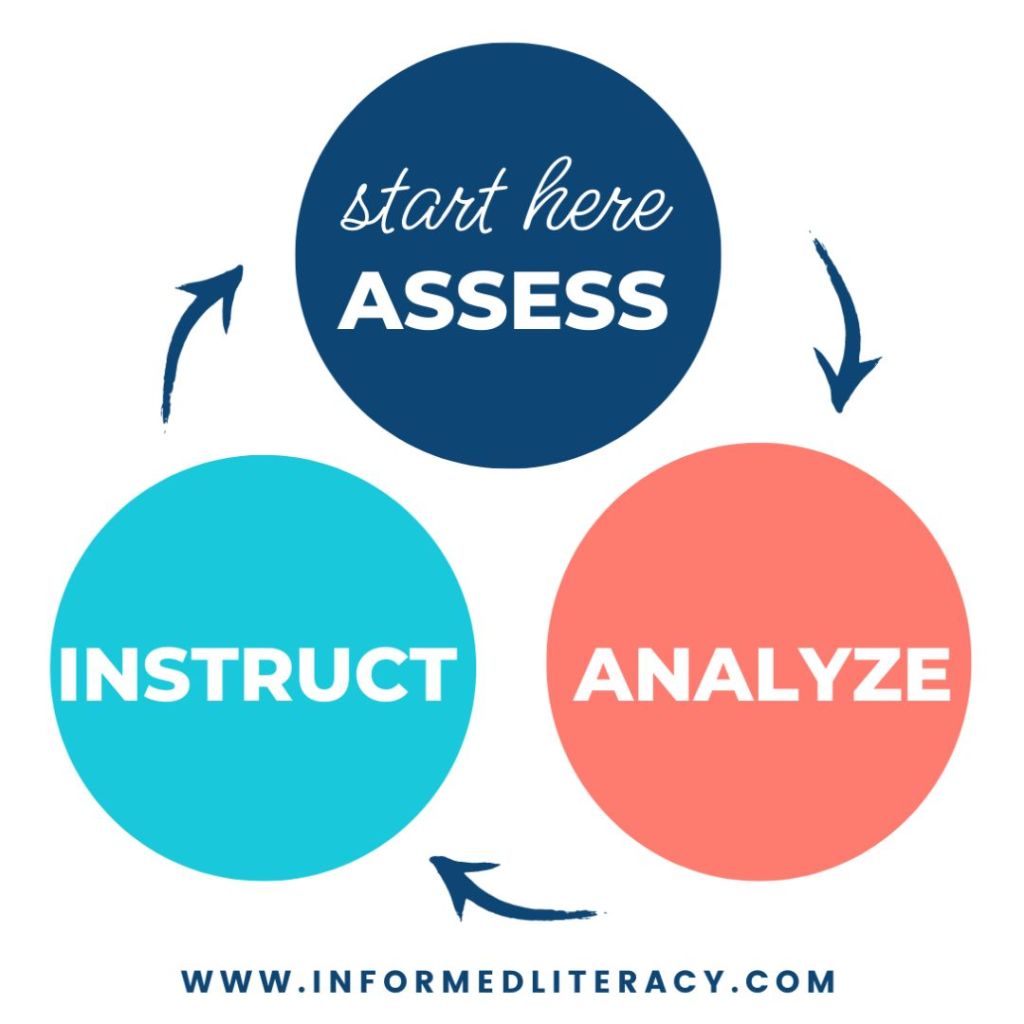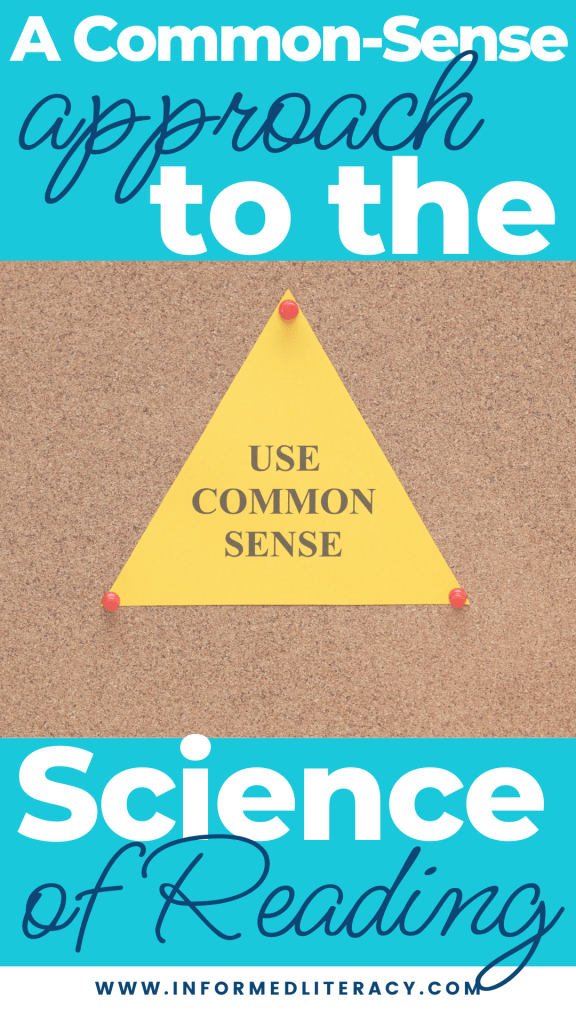A common-sense approach to the Science of Reading and literacy instruction is an essential part of being an effective educator. First and foremost, this approach requires that teachers adapt to the evolving nature of the Science of Reading. Following the science means being comfortable with discomfort. For the good of our students, we must embrace change as a sign of progress and improvement.
If educators can learn to accept the nuances of the Science of Reading, perhaps we can stop the all-or-nothing, black-and-white thinking, and halt the pendulum swing once and for all.
#1 – The Science of Reading is Constantly Evolving
- SOR is not static; it evolves with advancements in scientific understanding. Educators must embrace the idea that what we knew yesterday might not be the same today.
- As Benjamin Riley states in his article, Drawing on Reading Science Without Starting a War, “…science should inform – not dictate – practice.” The more we learn about the Science of Reading, the more we can improve upon our teaching methods. As we learn more, it doesn’t mean the Science of Reading was all wrong and we should go back to the old ways of doing things (i.e. whole language). This is what causes the pendulum swing for which the educational system is so well-known. We need to evolve with the science.
- Consider the analogy of a car. The first automobiles designed were nowhere near as intricate as the cars we drive now. These first cars had to be hand-cranked to start. Eventually, someone figured out how to design a car that could start with the turn of the key. At that point, did people throw their hands up in the air and say, “I KNEW cars were flawed. I’m going back to the horse and buggy!“? Of course not! Humans adapted and continued to accept each new and improved design of the automobile. Progress doesn’t invalidate the starting point; it refines it. We must embrace the evolving Science of Reading.
- Dr. Steven Dykstra notes that as more information becomes available, we must modify our beliefs over time. To hear more on his thoughts about the Science of Reading and informed practice in the classroom be sure to listen to The LIteracy View Podcast Episode 16, Steve Dykstra’s Interpretation of Mark Seidenberg’s Slide Deck – “Where Does the Science of Reading Go From Here? Season 3
#2 – Pacing and Using Data to Inform Instruction
The topic of pacing has come up over and over again in one-on-one discussions and on social media. Let’s face it, any program – even those aligned with the Science of Reading – is only as good as the instructor delivering it. So how can we get better?

- Use data to inform instruction. At Informed Literacy, we have always advocated for the process of, Assess, Analyze, Instruct. If 80% of the class did not master a particular concept, then it is incumbent upon the instructor to reteach that concept. If only 20% did not master the concept, the teacher must work with those students until they become proficient. Whole-class instruction, however, can move on to the next skill.
- Here’s a real-life example of phonemic awareness instruction. Some phonological awareness programs have a scope and sequence for first grade that includes syllable segmentation. However, in one particular classroom, the data indicated that every student had mastered that concept at the end of kindergarten. Should the first-grade teacher continue to work on syllable segmentation or move on to phoneme segmentation? The answer is, that time is precious and we have to make the most of it. If everyone has mastered the concept – move on to the next one.
#3 – Pacing and Progression
- Pacing concerning phonics instruction can be nuanced too. Understand that it’s critical to follow a scope and sequence to ensure that concepts are presented in gradually increasing difficulty. It’s also important to follow a scope and sequence to reduce the likelihood of skipping important instructional points. Most phonics-based curriculums have their own scope and sequence, but if you need one, we offer our Phonics Scope & Sequence for FREE.
- One issue we get questions about is the pace of phonics programs. The writers of these programs have the weighty task of designing a curriculum that meets the needs of learners across the nation. The default is to create a program that aims for the middle. This is where an informed teacher comes into play. Teachers know their students best and use data to help them make informed decisions. They know that some students grasp the reading code more quickly than others. The answer isn’t to make these students wait until everyone is ready. The answer is, as with the 20% who need additional instruction to catch up, learners who are quick to grasp concepts should be given targeted instruction in small group work.
#4 – Accept the Grey Areas
- What do I do with all my leveled readers? When SOR really took off and people finally began to understand the powerful positive impact that decodable texts have on emergent and struggling readers there was much lamenting about leveled readers. Some people advocated for throwing them all away. But, with a bit of reflection and a common-sense approach to the science of reading, there is no need for extreme actions like trashing perfectly good books.
- Let’s be clear: There is simply no place for the patterned leveled texts that require readers to look at the picture and guess-those can be trashed. Emergent and struggling readers should be presented with decodable text as they are acquiring key phonics skills. However, teachers need to use their common sense, student data, and a critical eye to determine the point at which non-controlled texts can be incorporated.
- When is the right time to make the shift? There’s a lot to consider-the data will help you decide. We need to stop thinking in terms of ‘levels’ because they are fairly arbitrary. That said, there are a number of high interest texts that can be found in leveled text sets. Rather than viewing them as ‘level J or K” let’s consider them non-controlled texts. As Louisa Moats states in ‘Speech to Print 3rd Edition‘, Book selections matter, too—students benefit from texts that enrich their vocabulary and stimulate deep thinking about important ideas and timely topics.
#5 – More Gray Areas…
- How do I assess my students if I can’t use running records? Another sticking point for those who adhere to the Science of Reading is how to assess students’ reading skills. Again, there has been an urge to discard the practice of running records. However, a common-sense approach to the Science of Reading leads informed educators to the understanding that running records per se are not bad. Rather, it is analyzing running records for MSV that is problematic. If we use decodable running records that align with instructional practice and analyze them for the skills that we expect our students to know, understand, and use, this assessment tool can provide a wealth of information. To learn more about how decodable running records can and should be implemented, read our post on What You Need to Know About Decodable Running Records.
Credentials Matter: It’s more than just memes & Instagram posts
Let’s be honest, we all love a good meme and there’s a lot to learned from the amazing SOR community on social media. If you’re reading this post, we KNOW you understand the importance of the Science of Reading and want to be a discerning consumer of information. You probably have your ‘go-to’ people and online resources for support. However, just because there’s a ‘Science of Reading’ label, we must understand that not every account is created equally. Here are some things we consider when following accounts:
Conclusion
A common-sense approach to the science of reading is the compass that guides teacher in the ever-evolving educational landscape. Change can be scary, but it’s a necessary part of growth and improvement. Remember, the evolution of the Science of Reading is about getting better. Just like the first cars paved the way for modern vehicles, our initial understanding of SOR is a foundation for ongoing improvement and refinement.
Related
#Navigate #CommonSense #Approach #Science #Reading






More Stories
SEND Funding Fact Check 2: Record funding or lack of cash? Which is true—and where’s the money gone? – Special Needs Jungle
Lamination Experiment – Mrs. D’s Corner
Must-Have Containers for Special Education Teachers – Simply Special Education